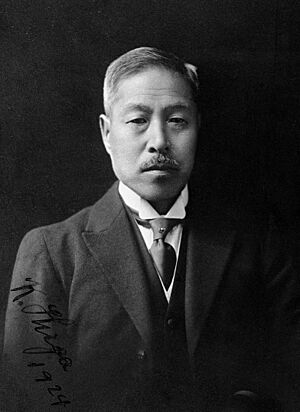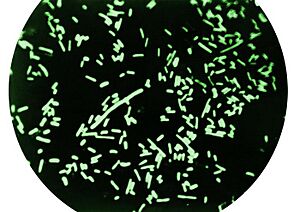Kiyoshi Shiga facts for kids
Quick facts for kids
Kiyoshi Shiga
|
|
|---|---|

Kiyoshi Shiga in 1924
|
|
| Born |
Kiyoshi Satō
February 7, 1871 Sendai, Miyagi, Japan
|
| Died | January 25, 1957 (aged 85) Sendai, Japan
|
| Nationality | Japanese |
| Alma mater | Tokyo Imperial University |
| Occupation | Medical Researcher |
| Known for | Discovery of Shigella |
Kiyoshi Shiga (志賀 潔, Shiga Kiyoshi, February 7, 1871 – January 25, 1957) was a Japanese physician and bacteriologist. He was a very smart scientist who made many important discoveries. In 1897, Shiga discovered a tiny germ called Shigella dysenteriae. This germ causes a serious sickness called dysentery. He also found the Shiga toxin, which is a powerful poison made by this germ. Kiyoshi Shiga also studied other diseases like tuberculosis and made big steps forward in understanding germs and how our bodies fight them.
Contents
His Early Life and Family
Kiyoshi Shiga was born in Sendai, Japan. His first family name was Satō, but he later changed it to Shiga, which was his mother's family name. He grew up during a time when Japan was changing a lot, which caused some money problems for his family.
In 1900, Kiyoshi Shiga married Ichiko Shiga. They had eight children together. He faced many sad times in his family life, including losing his wife and two of his sons.
Becoming a Scientist
Kiyoshi Shiga went to the Medical School of Tokyo Imperial University in 1896. There, he met Kitasato Shibasaburō, a very famous Japanese scientist. Kitasato studied germs and how the body fights diseases. Shiga was very interested in Kitasato's work. This led him to work at the Institute for the Study of Infectious Diseases, which Kitasato led.
While working at the Institute, Shiga became famous for discovering Shigella dysenteriae. This germ causes dysentery. He found it in 1897 during a big outbreak where many people got sick. The germ Shigella and the Shiga toxin are both named after him.
After his discovery, Shiga worked with Paul Ehrlich in Germany from 1901 to 1905. When he came back to Japan, he kept studying infectious diseases with Kitasato. Shiga became a professor at Keio University in 1920. Later, he was the president of Keijō Imperial University in Seoul from 1929 to 1931. He also advised the Japanese government in Korea on medical matters.
Kiyoshi Shiga received important awards for his work. He got the Order of Culture in 1944 and the Order of the Sacred Treasure when he passed away in 1957. He also wrote popular textbooks about germs and how the body fights them.
Discovering the Shigella Germ
After finishing medical school, Kiyoshi Shiga started working with Kitasato Shibasaburō. They focused on finding the germ that caused the dysentery outbreak in 1897. In 1898, Shiga successfully found and identified the germ. He did this by studying sick patients and following special steps called Koch's Postulates.
Using special coloring methods called gram staining, Shiga found that the germ was a type of gram-negative rod-shaped bacteria. He first called it Bacillus dysenteriae, but later it was renamed Shigella dysenteriae to honor him. This discovery also helped scientists find other similar germs.
Shiga also discovered the Shiga toxin, a poison made by the S. dysenteriae germ. He tried to make a vaccine from this toxin. His first attempt, a vaccine made from heat-killed germs, did not work and made him very sick when he tested it on himself. He then tried a different type of vaccine using horse blood, but it also did not help people become immune to the infection. Because of these problems, Shiga stopped trying to make a vaccine based on the Shiga toxin.
Fighting Other Diseases
Besides his work on Shigella dysenteriae, Kiyoshi Shiga also researched other diseases. These included tuberculosis, leprosy, and beriberi. He became very interested in how medicines could fight diseases and how the body's immune system works.
After discovering Shigella dysenteriae, Kiyoshi Shiga worked with Paul Ehrlich in Europe. They looked for new ways to treat a blood disease called trypanosomiasis, which is caused by a tiny parasite. Paul Ehrlich was known for using special dyes to find and kill certain germs and tissues. Their research led to the discovery of trypan red, a medicine that helped treat trypanosomiasis. In 1905, after this discovery, Shiga returned to Japan as a well-known scientist and continued his work.
Kiyoshi Shiga also helped with the development of the BCG vaccine for tuberculosis. In 1924, he brought a special type of tuberculosis germ, called BCG Tokyo 172 strain, from Paris to Japan. His work helped scientists grow this germ and create a vaccine to fight tuberculosis. Shiga believed strongly in vaccines and also in teaching people how to prevent diseases and stay healthy. He wrote many articles in Chinese about preventing diseases like tuberculosis.
See also
 In Spanish: Kiyoshi Shiga para niños
In Spanish: Kiyoshi Shiga para niños


